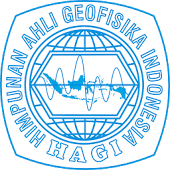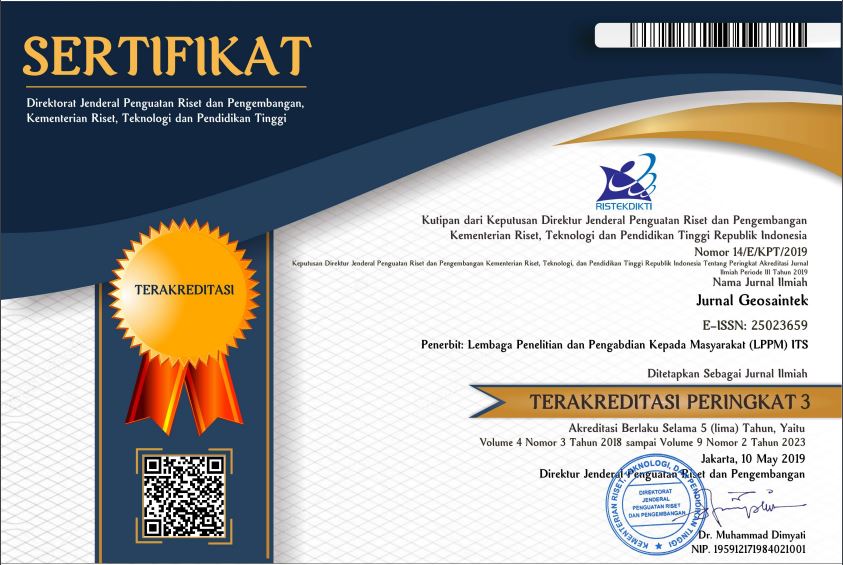URBAN HEAT ISLAND DI KOTA TANGERANG SELATAN
Abstract
Abstract. The industrial revolution opened up opportunities in changing people’s lives from an agrarian economic activity to an industry-based economy so that many people mass produced the phenomenon of migration. In 2018, 55% of the world’s population live in urban areas and by 20150 this will increase to 70 percent (United Nations, 2019). Migration disturbs the heat energy balance in urban areas as compared to suburban or surrounding areas, resulting in a temperature difference phenomenon known as urban heat island (Sharma et al. 2019). South Tangerang is one of the districts adjacent to the city of DKI Jakarta which is known as the world’s big city so it has vulnerability as a migration destination. So it is necessary to conduct a study that can provide an overview of the future phenomena of the emergence of potential urban heat island (UHI) that can be used as mitigation of the impacts of climate changes. As a results, from 2004 and 2020 there was an increase 0,30C UHI Index. The UHI phenomenon that occurs in South Tangerang City is also a result of existing developments in DKI Jakarta for areas that are directly connected to DKI Jakarta, such as Pondok Karya, Pondok Betung, and Cirendeu will experience urban growth.
Keywords
Geografi; Geoscience
Full Text:
PDFReferences
Dewantoro, Bayu Elwantyo Bagus, Pavita Almira Natani, and Zumrotul Islamiah. 2021. “Analisis Surface Urban Heat Island Menggunakan Teknik Penginderaan Jauh Berbasis Cloud Computing Pada Google Earth Engine Di Kota Samarinda.” Seminar Nasional Geomatika: 75.
Fawzi, Nurul Ihsan. 2017. “Mengukur Urban Heat Island Menggunakan Penginderaan Jauh, Kasus Di Kota Yogyakarta.” Majalah Ilmiah Globe 19(2): 195.
Grawe, David et al. 2013. “Modelling the Impact of Urbanisation on Regional Climate in the Greater London Area.” International Journal of Climatology 33(10): 2388–2401.
Kikegawa, Yukihiro, and Yutaka Genchi. 2006. “APPLIED Impacts of City-Block-Scale Countermeasures against Urban Heat-Island Phenomena upon a Building Õ s Energy-Consumption for Air-Conditioning.” 83: 649–68.
Mutanga, Onisimo, and Lalit Kumar. 2019. “Google Earth Engine Applications.” Remote Sensing 11(5): 1–5.
Sentinel-a, Menggunakan Citra Satelit, Studi Kasus, and Kabupaten Demak. 2018. “Analisis Ketersediaan Ruang Terbuka Hijau Dengan Metode Normalized Difference Vegetation Index Dan Soil Adjusted Vegetation Index Menggunakan Citra Satelit Sentinel-2a (Studi Kasus : Kabupaten Demak).” Jurnal Geodesi Undip 7(1): 202–11.
Sharma, Richa, Hans Hooyberghs, Dirk Lauwaet, and Koen De Ridder. 2019. “Urban Heat Island and Future Climate Change—Implications for Delhi’s Heat.” Journal of Urban Health 96(2): 235–51.
Sobrino, José A., Juan C. Jiménez-Muñoz, and Leonardo Paolini. 2004. “Land Surface Temperature Retrieval from LANDSAT TM 5.” Remote Sensing of Environment 90(4): 434–40.
Stewart, I. D. 2011. “A Systematic Review and Scientific Critique of Methodology in Modern Urban Heat Island Literature.” International Journal of Climatology 31(2): 200–217.
Zhao, Hongmei, and Xiaoling Chen. 2005. “Use of Normalized Difference Bareness Index in Quickly Mapping Bare Areas from TM/ETM+.” International Geoscience and Remote Sensing Symposium (IGARSS) 3: 1666–68.
DOI: http://dx.doi.org/10.12962%2Fj25023659.v8i2.11721
Refbacks
- There are currently no refbacks.

Jurnal Geosaintek diterbitkan oleh ITS bekerja sama dengan Himpunan Ahli Geofisika Indonesia (HAGI)
Disebarluaskan di bawah Lisensi Creative Commons Atribusi-BerbagiSerupa 4.0 Internasional.
Berdasarkan ciptaan pada https://iptek.its.ac.id/index.php/geosaintek/index.





